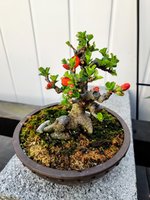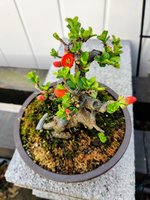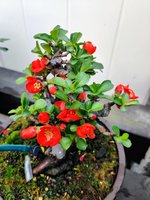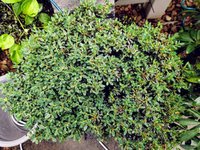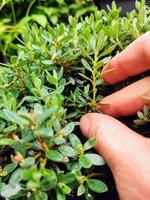JonW
Shohin
Maybe a bit early in the Spring to share - flowers aren't quite open yet, but I'm excited about these two. Actually, the rhodo doesn't have many flower buds which is probably good - I want it to just grow and gain vigor, but I don't know if I would have been able to push myself to remove any flowers.
Rhododendron Impeditum gets small, blue/purple flowers that cover the canopy. As you can see, the foliage is tiny, smaller than Azalea, and the leaves are very fragrant. Rhododendron foliage tends to be fuller than Azaleas as well. Impeditum can be a fickle variety. I just transitioned this one from a nursery pot with organic barky-compost to 1/8th inch pumice. I removed most of the organic soil but left the main root ball because these often don't respond well to full bare rooting in my experience. Despite being slow growers, this jumped into new growth after the repot, which gives me some confidence it will survive this first step in transitioning to bonsai, and grow roots into the pumice. I did some cleaning and removed dead and low, weak branches, but won't do any pruning until next year - I want it to push as much root as possible. Its in a 10-inch pond basket, so plenty of space for a few years. I plan to remove 25-50% of the remaining organic soil with each repot, so it will take a number of years, but the soil looked decent and there was a nicely shaped nebari of very fine roots. Its a twin-trunk and has some trifurcations/whirls that I will have to address in the future. If you can transition it to bonsai soil, I think this is a really nice variety for bonsai due to its small leaves and flowers.
I up-potted the chojubai in the fall, adding some 1/8th inch pumice. Its a really good start for a trunk since these things take so long to caliper. I'm looking forward to many years of enjoying the flowers while I do some clip-and-grow.
The top-dressing on both trees is sphagnum moss with dried green moss, and Jobe's organic fertilizer.
Rhododendron Impeditum gets small, blue/purple flowers that cover the canopy. As you can see, the foliage is tiny, smaller than Azalea, and the leaves are very fragrant. Rhododendron foliage tends to be fuller than Azaleas as well. Impeditum can be a fickle variety. I just transitioned this one from a nursery pot with organic barky-compost to 1/8th inch pumice. I removed most of the organic soil but left the main root ball because these often don't respond well to full bare rooting in my experience. Despite being slow growers, this jumped into new growth after the repot, which gives me some confidence it will survive this first step in transitioning to bonsai, and grow roots into the pumice. I did some cleaning and removed dead and low, weak branches, but won't do any pruning until next year - I want it to push as much root as possible. Its in a 10-inch pond basket, so plenty of space for a few years. I plan to remove 25-50% of the remaining organic soil with each repot, so it will take a number of years, but the soil looked decent and there was a nicely shaped nebari of very fine roots. Its a twin-trunk and has some trifurcations/whirls that I will have to address in the future. If you can transition it to bonsai soil, I think this is a really nice variety for bonsai due to its small leaves and flowers.
I up-potted the chojubai in the fall, adding some 1/8th inch pumice. Its a really good start for a trunk since these things take so long to caliper. I'm looking forward to many years of enjoying the flowers while I do some clip-and-grow.
The top-dressing on both trees is sphagnum moss with dried green moss, and Jobe's organic fertilizer.



